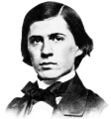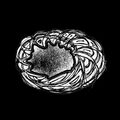Template:Selected anniversaries/April 19: Difference between revisions
No edit summary |
No edit summary |
||
| Line 1: | Line 1: | ||
<gallery> | <gallery> | ||
||Michael Stifel or Styfel (1487 – April 19, 1567) was a German monk and mathematician. He was an Augustinian who became an early supporter of Martin Luther. He was later appointed professor of mathematics at Jena University. Pic. | ||Michael Stifel or Styfel (1487 – April 19, 1567) was a German monk and mathematician. He was an Augustinian who became an early supporter of Martin Luther. He was later appointed professor of mathematics at Jena University. Pic. | ||
||Nicholas Saunderson (d. 19 April 1739) was a blind English scientist and mathematician. According to one historian of statistics, he may have been the earliest discoverer of Bayes theorem. Pic. | |||
||Gustav Theodor Fechner (b. 19 April 1801), was a German philosopher, physicist and experimental psychologist. An early pioneer in experimental psychology and founder of psychophysics, he inspired many 20th century scientists and philosophers. He is also credited with demonstrating the non-linear relationship between psychological sensation and the physical intensity of a stimulus which became known as the Weber–Fechner law. Pic. | ||Gustav Theodor Fechner (b. 19 April 1801), was a German philosopher, physicist and experimental psychologist. An early pioneer in experimental psychology and founder of psychophysics, he inspired many 20th century scientists and philosophers. He is also credited with demonstrating the non-linear relationship between psychological sensation and the physical intensity of a stimulus which became known as the Weber–Fechner law. Pic. | ||
Revision as of 06:26, 29 April 2018
1881: Mathematician Karl Mikhailovich Peterson dies. He discovered equations which were subsequently named the Gauss–Codazzi equations, fundamental to the theory of embedded hypersurfaces in a Euclidean space.
1882: Large herd of Flying bison (Bison pterobonasus) migrates from Periphery to New Minneapolis, Canada.
1912: Chemist Glenn T. Seaborg born. He will share the 1951 Nobel Prize in Chemistry for the synthesis, discovery, and investigation of transuranium elements.
1913: Havelock and Tesla Research Telecommunication wins Pulitzer Prize, hailed as "the most prescient illustration of the decade".
1914: Mathematician and philosopher Charles Sanders Peirce dies. He is remembered as "the father of pragmatism".
1932: Mathematician Giuseppe Peano publishes new class of Gnomon algorithm functions which use set theory to detect and prevent crimes against mathematical constants.
2016: Theoretical physicist, theoretical chemist, and Nobel laureate Walter Kohn dies. He developed density functional theory, which makes it possible to calculate quantum mechanical electronic structure by equations involving the electronic density.
2017: Steganographic analysis of Shell unexpectedly reveals "at least four-thousand and ninety six kilobytes" of encrypted data.







